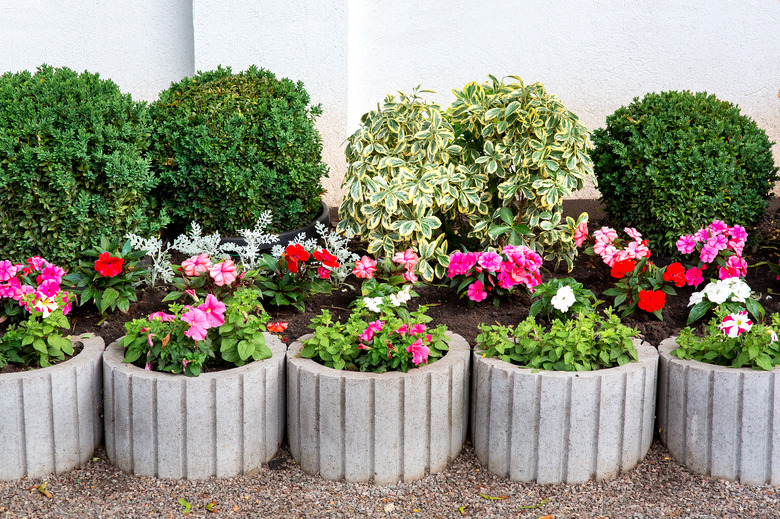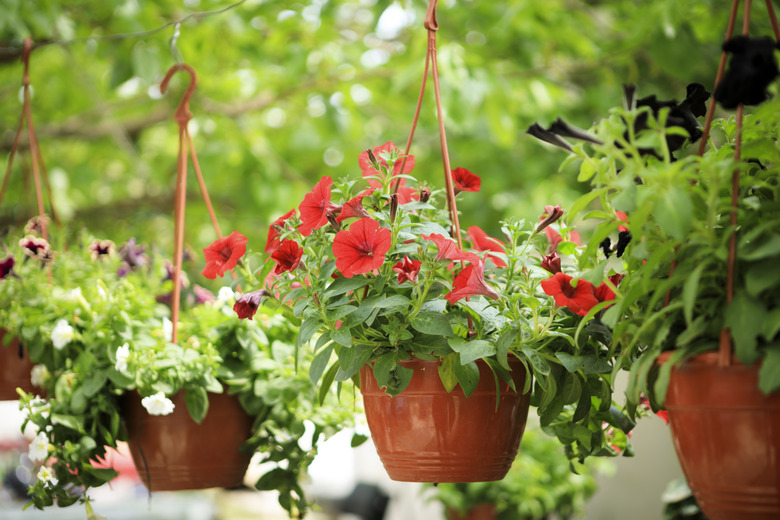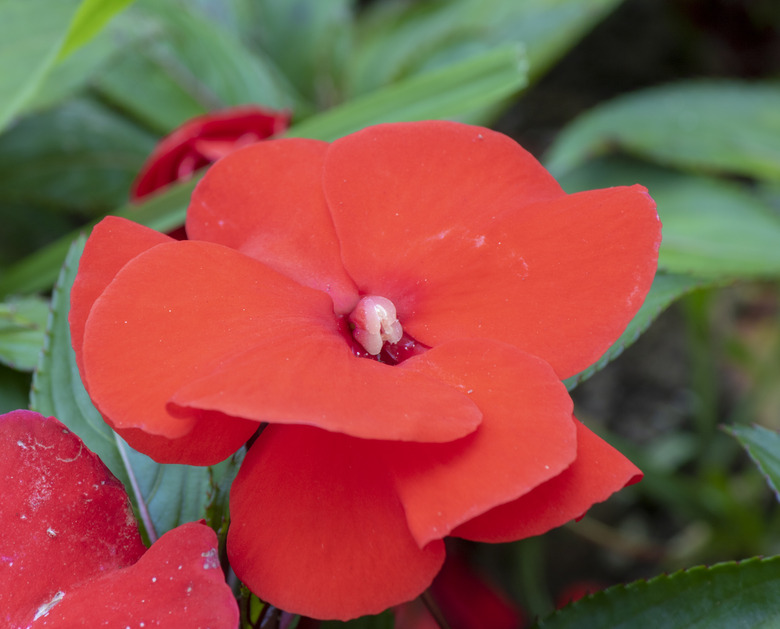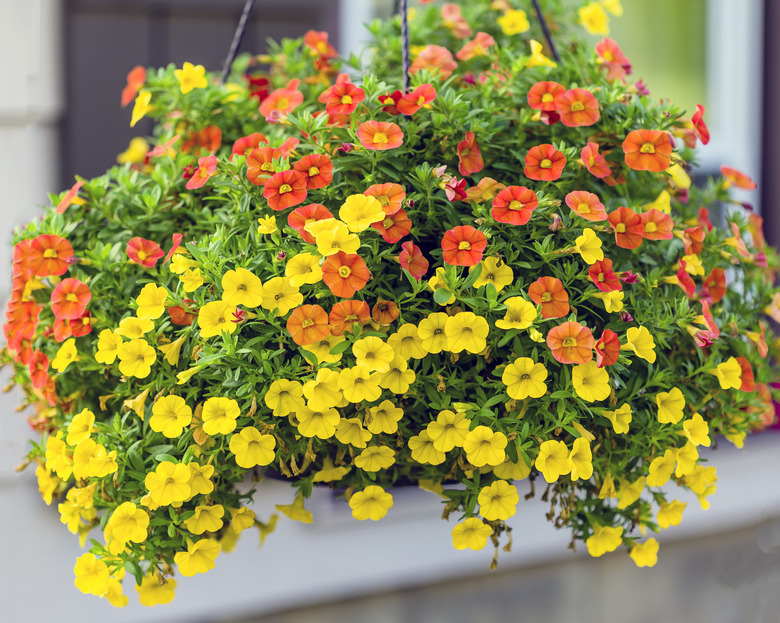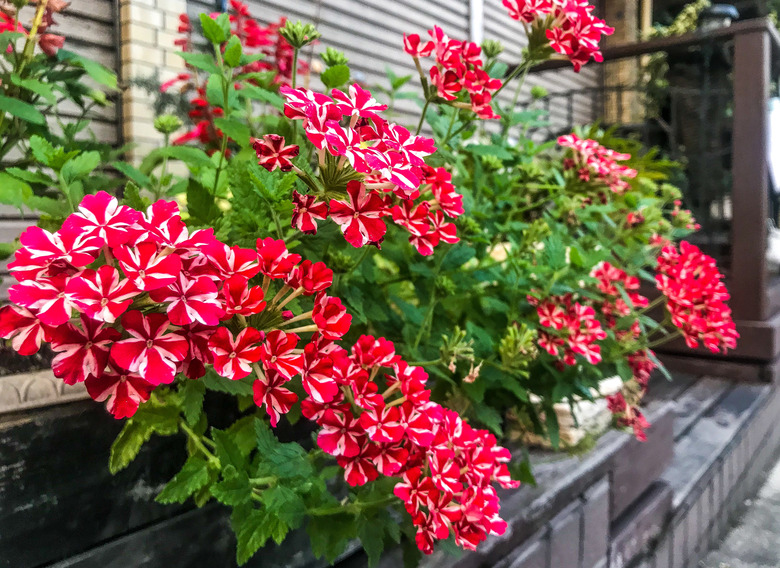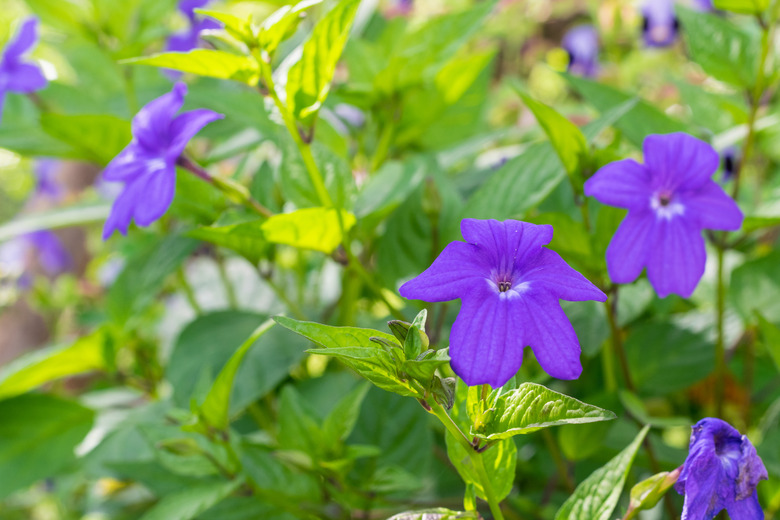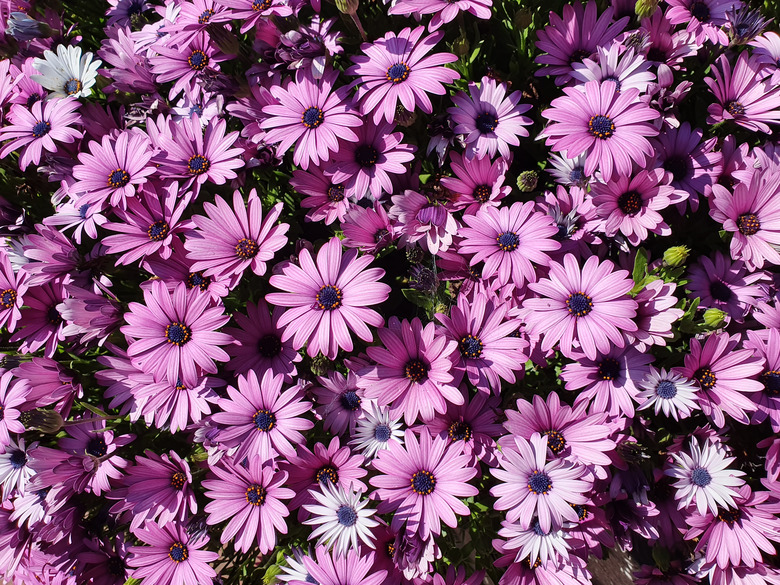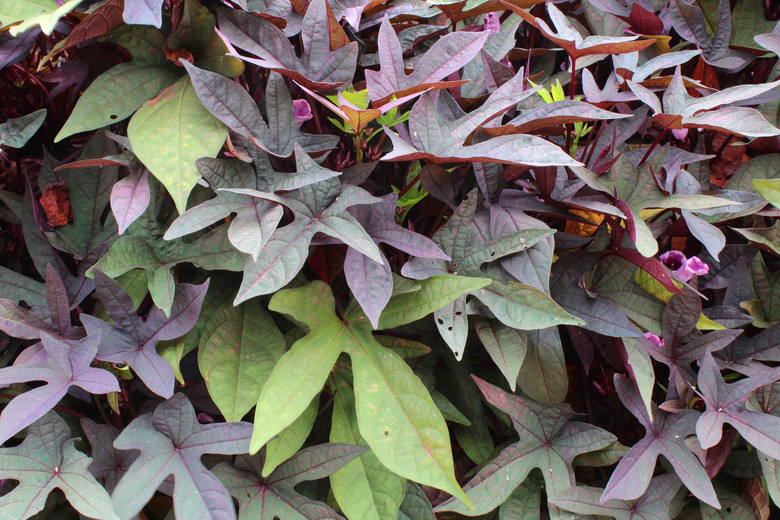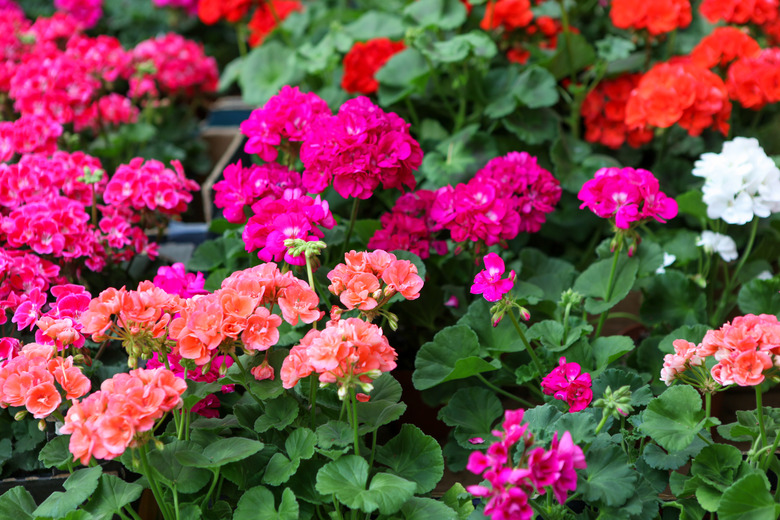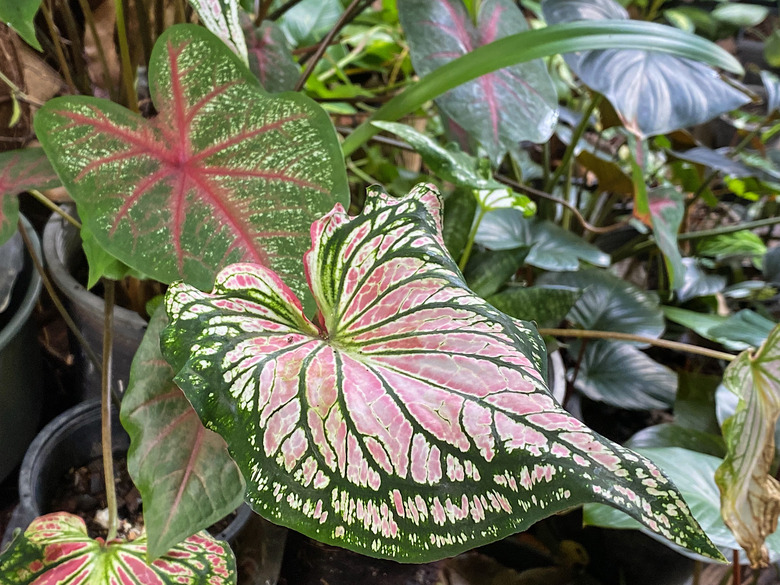The 9 Best Annuals For Container Gardens
We may receive a commission on purchases made from links.
If you plan to grow a container garden on your porch, balcony or patio, you might love the idea of having a beautiful splash of colors throughout the spring and summer. While some people prefer growing perennials to keep the same plants alive every year, annual gardens are a fun and easy way to add an array of colors to your space, which can vary from year to year.
Looking to liven up your front porch with a colorful splash of annuals? Here are our nine favorites.
1. Petunia
1. Petunia
Garden petunias (Petunia x hybrida) have been so popular for so long that some people consider them to be "granny flowers," but there are good reasons for their widespread appearance in gardens for more than 100 years: Petunias are easy to grow and beautiful. The classic petunia has funnel-shaped blooms, which are available in a wide range of colors, including pink, purple, black, blue, yellow, red and white. Color patterns may be solid, striped, streaked or picotee, which means that the tips of the petals have contrasting colors only on the edges. If you don't like the trumpet look of classic petunia flowers, don't immediately bypass them — just look for the pirouette grandiflora petunias with ruffled petals that look more like carnations.
Petunias are annuals in most areas but can survive as perennials in zones 10 and 11. They should be protected from intense afternoon sun in those regions. These flowers can survive in partial shade but will produce more blooms if grown in full sun as long as they aren't harmed by overly warm direct sunlight. Petunias have moderate water requirements. Deadhead flowers to encourage more blooms. To keep the plants bushy, pinch back stems when they start appearing too leggy.
2. Walleriana and New Guinea Impatiens
2. Walleriana and New Guinea Impatiens
Behind petunias, some of the most popular flowers commonly grown in containers are impatiens, with the most common species also commonly called "busy Lizzy"(Impatiens walleriana). These small, shrubby, flowering plants are perennials only in the frost-free zones of 10 and 11, but gardeners outside these zones can keep them alive throughout the year by taking them indoors during the winter, though most gardeners grow them as annuals. The plants tend to grow around 8 to 24 inches tall, with their deep-green leaves covered in flat flowers of white, red, pink, peach, purple or coral.
One great thing about impatiens is that unlike most flowers, they prosper in shady areas, allowing you to add a bright splash of color in the dark corners of your porch or balcony. If you love the look of these flowers but want to grow them in a sunnier area, look for their cousin, New Guinea impatiens (Impatiens hawkeri), which have the added benefit of more colorful leaves adorned with splashes of yellow or red. Keep in mind that even New Guinea impatiens should be protected from direct sunlight during the peak midday heat.
Regardless of whether you're growing walleriana or New Guinea impatiens, these flowers do not do well with drought, so do not let the soil dry out. Mulching can help maintain even moisture levels.
3. Million Bells
3. Million Bells
These cute flowers look like small petunias and are prolific bloomers, producing flowers in pastels as well as bold shades of red, orange, white, pink, yellow, blue and violet. Depending on the variety, they can make great fillers or spillers because some are bushy plants growing to about 8 inches, while others tend to creep along the ground, happily trailing outside the edge of a planter box or basket. Million bells (Calibrachoa x hybrida) are annuals in most of the country, but they are perennial in zones 9 through 11, and in warm, humid areas, such as Florida, they survive much better in the heat than petunias.
Although million bells like full sun, they will do better in hot areas if they are protected from harsh afternoon sun. To keep the plants from getting too leggy, pinch off the top of the plants.
4. Verbena
4. Verbena
Garden verbena (Verbena x hybrida, zones 9-11) is famous for cascading over the sides of pots and baskets with miniature clusters of blooms that come in light and bright shades of pink, purple, coral, red and white. These great accent plants are particularly low-maintenance and heat tolerant, making them a great addition to just about any container garden. As a bonus, verbena will attract all kinds of pollinators, including hummingbirds, butterflies, and bees.
Make sure your verbena plants get full sun. These plants are drought tolerant but don't like excess moisture, so it's often best to ensure the soil dries slightly before you water again. While verbena doesn't require deadheading, you may need to trim back the plants to prevent them from taking over containers. Trimming will also result in your plants growing bushier and developing more flowers.
5. Browallia
5. Browallia
Browallia (Browallia speciosa) is best known for its bright-blue blooms that grow in a star shape, though it also comes in purple or white colors. With its striking appearance and mounded shape, this flower can play any role in a container, serving as a stand-out addition, filler or a spillover enhancement along the edge. While normally grown as an annual, these plants are perennials in zones 9 through 11. Outside this hardiness range, they can be brought indoors and grown as houseplants during the winter.
Browallia grows well in partial shade and should be kept out of direct sunlight, which will burn its leaves. Take care not to allow the soil to dry out, as this plant does not do well in drought conditions. Pinch back the plants to keep foliage bushy and to encourage more blooms.
6. Gazania
6. Gazania
Are you looking for a particularly striking flower to stand out from the rest of the plants in your container garden but want something that's still hardy and easy to grow? Look no further than gazania (Gazania rigens), also called African daisy or "treasure flower." These low-maintenance beauties grow from 6 to 12 inches tall, sprouting orange daisy-like flowers about 3 or 4 inches wide. Hybrid cultivars offer a wider range of flower colors and patterns, including yellow and white, and some even have striped flower petals with a contrasting color on the edges of each petal. The flowers attract pollinators, like birds, butterflies, and bees.
Plant gazania in full sun approximately 1 foot apart. Let the soil dry a little between waterings. Once established, these daisies are drought tolerant and very heat tolerant, but to maximize blooms, keep watering on a regular schedule during summer. Deadhead flowers until the end of the season to encourage repeat blooming.
7. Ornamental Sweet Potato Vine
7. Ornamental Sweet Potato Vine
An ideal spiller plant for any large container, ornamental sweet potato vines (Ipomoea batatas, zones 9-11) are notoriously hardy and can survive in full sun or full shade as long as they have moist, well-draining soil. True to its name, the plant does produce tuberous sweet potatoes, but these are low quality and should not be eaten. The leaves come in a wide array of colors, including chartreuse, purple, copper or even black shades.
Because each vine has the potential to grow up to 10 feet long, it's important to make sure to grow these plants in containers large enough to give them room to grow; otherwise, be prepared to trim back the vegetation regularly. Keep them out of the hot afternoon sun if you live somewhere particularly warm, such as zone 10 or 11, but otherwise, these plants enjoy full sun. Do not fertilize them or it can cause the plants to overtake your container.
8. Garden Geranium
8. Garden Geranium
There are so many types of garden geraniums (Pelargonium) that it can be difficult to describe them all, but they're all great additions to a container garden. They produce flowers in red, pink, orange, white, purple and more. A few notable types include:
- The classic zonal geraniums are the ones most
people envision when they hear the name. These feature rounded green leaves that have darker bands, or zones, with clusters of flowers growing on long stalks. - Ivy-leaved geraniums are great for hanging
baskets because the long stems of the flowers often hang all the way down to
the ground or over the sides of the basket. - Regal geraniums have large and sometimes patterned
flowers that grow in clusters. Their leaves often have a pleasant scent, making
them a good choice for any container garden grown close to a home's doors or
windows. - For a particularly aromatic option, look for
scented-leaf geraniums that smell like other plants, including pineapple,
orange, lemon, rose and peppermint.
Overall, most geraniums prefer cool nights and warm days in full sun, but they prefer shade from harsh afternoon sun. Although you can grow them as annuals, you may keep them alive year-round if you take them indoors before cold weather begins and keep them near a sunny window.
Geraniums are fairly easy to grow but take care not to overwater them because they are prone to a number of diseases and pests, many of which thrive in overly wet conditions. To keep plants bushy, pinch back regularly and deadhead flowers to increase productivity.
9. Caladium
9. Caladium
You can have a colorful container garden even without growing flowers. Caladiums (Caladium) are a great option, with their colorful, heart-shaped leaves available in solid colors as well as variegated options and patterns that include speckling and contrasting leaf margins or midribs. While most caladiums grow between 2 and 3 feet tall, there are also dwarf cultivars about 1 foot tall that work well in smaller containers.
Caladiums are a great choice to brighten shady spots on your porch or balcony, as they love partial and full shade, and they can also be grown as houseplants. That being said, some newer cultivars are sun-tolerant, although direct afternoon sun may be too harsh in warm climates. The caladium is native to tropical regions, so it needs a fair amount of humidity and cannot handle cold weather, even at night. For this reason, it prefers very moist though still not soggy soil, so be sure to grow them in containers with other water-loving, shade plants.
Gardening Tips for a Container Garden
Gardening Tips for a Container Garden
Container gardens are unique in that they allow you to grow a wide array of plants with widely differing needs as long as those sharing a planter also have similar needs. Here are some good tips for starting your container garden:
- Use a basic potting soil: When it comes to soil requirements, most plants recommended as container plants do just fine with a basic potting soil that drains well and is rich in organic matter. Similarly, most of these plants do well with a bimonthly or monthly dose of water-soluble, 10-10-10 fertilizer. You can also use a slow-release fertilizer, which gradually releases nutrients over the growing season.
- Keep in mind the watering requirements if combining different plants: While most container-grown plants require regular waterings to keep the soil moist but not soggy, it is still a good idea to keep drought-tolerant plants and water-loving plants in different containers.
- Be mindful of how much space each plant needs: Also, remember that some plants require a lot more space than others, so be sure to research a plant's space requirements before you plant something in a small pot that would do better in a large container.
- Think about aesthetics: Selecting the right plants to go together in a single container isn't just a matter of finding a few varieties with similar care requirements. It also involves choosing plants that will look good together. While you might be inclined to choose an array of beautiful annual flowers to add to your container garden, just selecting a bunch of pretty flowers may leave you with a garden that looks too busy since your stunning blooms may end up competing with one another. If you want to have the best garden of annuals in your neighborhood, you'll need to find a good balance among your container plants.
- Always have spillers, thrillers, and fillers: A good rule of thumb when mixing plants in a single container is to try to create a good combination of taller eye-catching thrillers and some lower-growing fillers to complement but not compete with these tall plants. You may also want to grow some creeping plants to tumble over the side of the container, creating a little more visual interest than your hanging baskets and window boxes may have on their own.
